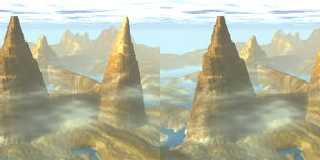|
 |
> > Chris:
> > Where does this "rule of thumb" come from? Your eyes don't get farther
> > apart when looking at distant objects, they stay the same distance apart
> > and rotate to be closer to parallel.
> Bob:
> I agree with Chris here that following actual human eye characteristics
must
> be the way to go, however maybe the reasoning not to do so has to do with
3D
> photography in some way.
***
Correct . . . the angle of convergence is the thing we need to simulate.
The 1:30 was just something I recall using just to get the effect close.
I think that's like looking at something about 7 or 8 ft away which covers
a lot of renderings of scenes that contain just one abstract object . . ..
However, when simulating a real world scene, it does become important
to maintain the perspective.
Again . . . we see that simulating what the human eye/brain is capable of
doing is quite a task, eh? The eye can adapt to different ranges of color,
brightness and focal distances automatically . . . we aren't even aware
that it takes place. However, when using a camera or POVray to render a
3D scene, we have to pick one spot and get the settings right or it won't
look like what the eye/brain sees.
I have done 3D photograpy for 30 years and with the camera, it's pretty
straight-forward . I pick the object of interest and take the left and
right
shots ensuring that when I make the shift ( about 3 inches in this case . .
.
just simulating the eye separation) that the object of interest is what I
keep centered. The result is . . . the difference in the angle from the
left
and right view will accuratly simulate the angle that the eyes use to focus
on the object of interest. If focused at infinity, it would be zero, and as
the
distance from eye to object decreases, the angle of convergence increases.
The brain, which has learned through experience, uses both this angle to
focus the eye and the relative horizontal shift of the objects in the view
to
determine depth and perspective. And . . . notice that the object of
interest
will not shift while objects closer will shift left and those farther away
to the right. Well . . . it's all relative . . . but focusing on the object
of
interest is important.
With POVray . . . we have to caculate the proper camera shift. There is
no need to calculate the angle . . . just the relationship of distance to
shift.
(Although that would be useful if we are rotating the camera around the
object by degrees - simple trig function, eh?)
If the object is 10 foot away and we use 3 inches for eye separation, we
will want to shift our camera 3in/120in or 0.025 units for every unit of
distance to the object. For 30 foot . . . 3/360 or 0.00833 units of shift
per
unit of distance. Of course you can deviate from this formula to enhance
the effect but . . . at some point it will no longer appear realistic.
And . . . using focal-blur to simulate depth-of-field would also enhance
the effect. Keep the target object in sharp focus. That's the reason I
rotate
around the object of interest when using the camera for 3D photos . . . the
brain uses that convergence data to tell the eye the distance to focus at
and we want to simulate that too to make it as realistic as possible.
Have attached a 3D pic I found on the web . . . on a site for MathArt . . .
http://www.lvcablemodem.com/esullivan/webquest.html
This is a very nice example of what can be done.
Y
cross-eyed and unfocused . . . SOP ;)
Post a reply to this message
Attachments:
Download 'mstytwrp.jpg' (14 KB)
Preview of image 'mstytwrp.jpg'

|
 |




![]()